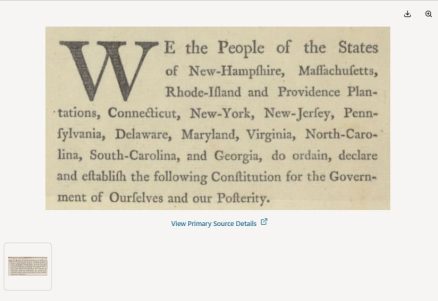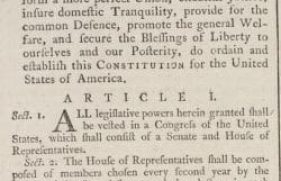We the People: Elementary Edition

Published By:
Historical Era:
Thinking Skill:
Bloom’s Taxonomy:
Grade Level:
Suggested Teaching Instructions
This activity can be used to introduce the Constitution, the concept of self-government, and the role of the Constitution in creating community. It would also be appropriate during a unit on the Constitutional Convention and the ratification process. For grades 3-5. Time needed is approximately 45 minutes.
Before beginning activity, share the following details with students:
Delegates from across the United States met as part of the Constitutional Convention in Philadelphia, Pennsylvania, from May 25, 1787, through September 17, 1787.
The first printed draft was prepared for the delegates to show the resolutions and current language of the document on July 23, 1787 (the first document seen in the activity).
In September, delegates appointed a committee to revise and arrange the articles of the Constitution – including changing the language of the opening of the Constitution, known as the Preamble. On September 17th, 39 delegates signed the Constitution and sent it to Congress for approval before being sent to the states for ratification.
This version of the finalized text (the second document in the activity) was printed on September 29, 1787, based on the type already set by the New York newspaper the Independent Journal.
Begin the activity as a full class, or ask students to work in pairs or small groups. They should consider the following questions as they examine the two documents displayed:
- What are the major differences between the draft of the Preamble and the final version?
- Why do you think the wording was changed?
- How do these differences help explain the purpose of the Constitution?
- What words added to the Preamble suggest the need for building a unified American community?
Note: To prevent any misunderstanding, inform students that both versions use a now-antiquated version of a long s (ſ) that appears similar to a lowercase f.
Once the students have responded to the questions, hold a class discussion based on their answers. Focus attention on which parts of the Preamble changed and which parts stayed the same. Ask students to hypothesize reasons for some of the changes.
Inform students that the first major change involved opening the Preamble with the words, “We the People of the United States,” rather than listing each state individually. The second change lengthened the Preamble, which explained the document’s intention to establish a new government and outlined the purposes of the new government. Another major change throughout was including words like United, Union, common, and general to explain how this new Federal form of government was trying to be a more unified country different than the earlier Articles of Confederation.
Next, direct students to click on “When You’re Done” to complete the final part of the activity. Show students the language of the finalized Preamble. Inform students they will be going through the Preamble line-by-line to understand the purposes of the government outlined in it. As a class, they will be writing a kid-friendly version.
Break the class into small groups, with each focused on rewriting one line of the Preamble:
- We the people, of the United States,
- in Order to form a more perfect Union,
- establish Justice,
- insure domestic Tranquility,
- provide for the common defense,
- promote the general Welfare,
- and secure the Blessings of Liberty to ourselves and our Posterity,
- do ordain and establish this Constitution for the United States of America.
As they read their line, ask students to note which words they don’t understand. If needed, direct students to look up those words in a dictionary.
Bring all of the individual groups together and write a new kid-friendly Preamble. As each group shares their new line, ask other students to comment or offer additional edits. After you finalize the wording, post it in the classroom alongside the original Preamble.
If additional classes in the school have completed the same activity, post each class’s version in the hallway and have them visit the other versions. Discuss the major similarities and differences.
Description
In this activity, students will 1) examine the Preamble as seen in the original draft and final version of the Constitution, and evaluate the significance of the changes in the text, and 2) rewrite the Preamble in their own words.
Share this activity with your students
Documents in this Activity

George Washington's Annotated Copy of a Draft of the U.S. Constitution